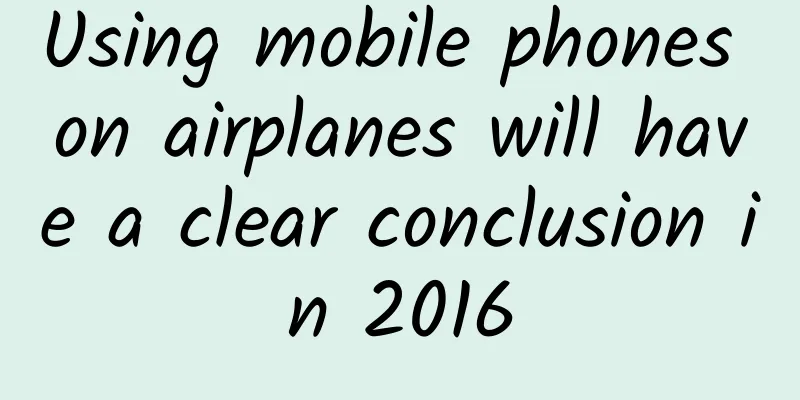Using mobile phones on airplanes will have a clear conclusion in 2016

|
At present, every time passengers take a flight in China, they are required to turn off their mobile electronic devices such as mobile phones, and they are not allowed to use them even if the mobile phone is set to "flight mode". However, countries and regions including the United States, the European Union, and Singapore have made it clear that mobile phones can be used during flights, but they need to be set to "flight mode". In my country, although major airlines have begun to explore the commercialization of in-flight WiFi, mobile phones are still listed as strictly prohibited electronic devices for flight safety considerations. The reporter's investigation found that behind the policy red line, there is actually only one step between lifting the ban and strict control. status quo Many countries lift ban on mobile phone use on airplanes Recently, the Civil Aviation Authority of Singapore announced that it would relax restrictions on the use of portable electronic devices on flights. After the new regulations are implemented, passengers can use mobile phones, tablets and other electronic devices in "flight mode" throughout the flight as long as wireless communication or remote control functions are not enabled. Electronic devices that require wireless communication connections or remote control can be used when the flight climbs above 10,000 feet (about 3,048 meters), but voice calls are excluded. In fact, Singapore is not the first country to lift the ban on mobile phone use on airplanes. As early as October 2013, the US Federal Aviation Administration approved the use of mobile electronic devices such as smartphones, tablets, MP3s, digital cameras, and e-books during takeoff and landing, but they must be set to "flight mode", that is, the mobile phone's external communication function is turned off. Last December, the European Aviation Safety Agency also announced the same rule, lifting the ban on the use of mobile phones in "flight mode" during the entire flight. The head of media affairs of the European Aviation Safety Agency said that the introduction of this regulation has undergone rigorous safety demonstration and is aimed at meeting people's needs to use electronic devices anytime and anywhere. Zhou Hong, an expert member of the Aviation Public Communications Association Alliance, told reporters that since many countries have already allowed the use of mobile phone "flight mode" on airplanes, my country's Civil Aviation Administration is exploring the feasibility of allowing the use of flight mode at altitudes above 3,000 meters. Currently, technical verification has begun and clear results are expected to be available by 2016. "With the experience of European and American countries, the technical verification results are still very optimistic and the possibility of allowing it is very high," Zhou Hong said. Causes High risk of use during takeoff and landing According to international practice, portable electronic devices such as mobile phones, laptops, iPads, MP3s, and game consoles are not allowed to be used at altitudes below 10,000 feet. When the aircraft reaches above 10,000 feet, all electronic devices except mobile phones can be used. We were told that there is only one reason for this rule: in theory, they may interfere with flight instruments. Several civil aviation experts told reporters that during the flight, the pilot uses the onboard radio navigation equipment to maintain real-time contact with the ground navigation station to control the flight route. When the aircraft reaches the cruising altitude and flies steadily, it is 6,000 to 12,000 meters above the ground. At this time, the mobile phone cannot receive the signal and cannot be used. During takeoff and landing, due to the low altitude, the mobile phone can get in touch with the ground base station, which interferes with the navigation system the most. In the case of low visibility, the aircraft needs to use the instrument landing system to land. At this time, the blind landing station on the runway will send electromagnetic signals to the aircraft to determine the runway position. If the mobile phone is not turned off, it may cause serious interference. "Mobile phones not only emit electromagnetic wave signals when making or receiving calls, but also keep in touch with ground base stations when in standby mode. In the process of searching for signals, although the time for each signal transmission is very short, it has strong continuity. Therefore, the electromagnetic waves emitted by mobile phones will interfere with the aircraft's navigation system." said Su Ye, an expert from the Science Squirrel Society. Compared with the impact on the aircraft communication system, the impact of using mobile phones on the plane on the mobile phone ground base station is obvious. Su Ye pointed out that when a mobile phone user moves from one area to another, it is necessary to reselect and switch base stations, and this process requires calculation. When passengers use mobile phones on the plane, due to the high speed of flight, the switching between areas will be very frequent, which will increase the workload of the base station. Disable just in case It is understood that there are hundreds of types of avionics equipment on passenger aircraft, and the main ones that use radio are navigation systems and air collision avoidance systems. Among the main airborne navigation and communication systems, the frequency band used by VOR and ILS localizer is 108-118MHz, the frequency band used by ILS glideslope is 329-335MHz, and the frequency band used by DME and TCAS is 960-1215MHz. However, among the communication frequency bands of all mobile phones, GSM 900 uses 890-960MHz, GSM1800 uses 1710-1850MHz, CDMA uses 825-880MHz, and the main working frequency band of 3G is 1880-2025MHz, while the 4G frequency band approved by the Ministry of Industry and Information Technology is the high frequency band such as 2575-2635MHz. "It can be said that the communication frequency bands used by airplanes and mobile phones are parallel lines that do not interfere with each other, and the distance is very far, so there is no interference in theory," Zhou Hong said, "but this is only in theory." Shu Huaying, a professor at Beijing University of Posts and Telecommunications, told reporters that there are many mobile phone manufacturers in China, and some counterfeit mobile phones have not even obtained network access licenses. Due to different transmission powers, different mobile phones may generate high-order ramp waves during operation. These "clutter" are irregular and may overlap with the frequency band of the aircraft's communication system, causing interference to the aircraft. "In addition, mobile phones with poor filtering performance may also generate secondary and tertiary ramps, and there may be jumps between the ramps, which may affect the aircraft." Shu Huaying said, "But this possibility is very small. So far, there has been no aircraft accident caused by turning on the mobile phone. But for the sake of flight safety, the civil aviation department still strictly controls mobile phones with the attitude of not letting any one go to ensure the safety of passengers." Link The main regulations of various countries European Union As of November 2013, mobile phones and other portable electronic devices can be used in "flight mode" throughout the flight. USA As of October 2013, mobile phones and other portable electronic devices can be used in "flight mode" throughout the flight. Canada In May 2014, the "flight mode" of mobile phones and other portable electronic devices can be used during the entire flight. United Arab Emirates In January 2007, Emirates Airlines allowed the use of mobile phones to make calls and send and receive text messages at an altitude of 20,000 feet (about 6,096 meters). Japan All electronic devices including mobile phones and tablets cannot be used during takeoff and landing of the plane, and mobile phones cannot be used throughout the entire journey. We are studying to relax policy restrictions and plan to allow the use of mobile phones in "flight mode" during takeoff and landing. China All electronic devices, including mobile phones and tablets, cannot be used during takeoff and landing. Mobile phones are not allowed to be used throughout the entire process. The technical verification stage is currently underway, and the plan is to allow the use of "flight mode" on mobile phones during takeoff and landing. The power of other portable electronic devices does not need to be turned off throughout the entire process. Explanation Why can I use the Pad during flight? According to the "Large Aircraft Public Air Transport Carrier Operation Qualification Certification Rules" issued by the Civil Aviation Administration of China in January 2010, mobile phones, including those in flight mode, are prohibited throughout the flight because they are devices that can actively transmit radio signals. However, portable computers, iPads and other devices do not actively transmit radio signals and can be used except during critical flight stages such as takeoff, climb and landing. So, what is the difference between the permitted electronic devices such as iPad and the "flight mode" of mobile phones? Zhou Hong told reporters that even if the mobile phone is set to "flight mode", it is still a transmitter, while iPads and laptops only have receiving functions and do not actively transmit signals. However, experts in the telecommunications industry believe that "airplane mode" is not fundamentally different from iPads and laptops. "All mobile electronic devices generate electromagnetic waves, but the strength of the electromagnetic waves varies." Shu Huaying said that iPads and laptops both have WiFi functions, which will also cause the same problem. Satellites, ground base stations, and electronic devices will generate two-way communication after turning on WiFi hotspots, so they will also emit radio waves. "After turning on the 'flight mode', the mobile phone's transceiver modules are completely turned off, and the cellular communication system will no longer establish contact with the ground base station." Shu Huaying said, "However, there are many counterfeit mobile phones in China, and whether the filter performance is guaranteed after turning on the 'flight mode' is a possible hidden danger." According to He Guili, director of the Ministry of Industry and Information Technology's Telecommunication Technology Laboratory, mobile devices such as iPads do not have communication functions and therefore cannot be misoperated. However, mobile phones have communication modes and will try to contact ground base stations. "The civil aviation department is worried that this signal will interfere with aircraft." Outlook It will take some time for civil aviation policies to be relaxed While we are still discussing whether "flight mode" should be allowed on airplanes, domestic civil aviation communication technology has entered the commercialization stage of in-flight WiFi and the technical demonstration stage of making phone calls on airplanes. Just in July, following Air China's test flight of the "Air Broadband System" aircraft, China Eastern Airlines and China Southern Airlines also obtained approval from the Civil Aviation Administration and the Ministry of Industry and Information Technology to provide in-flight WiFi for ordinary passengers on their modified aircraft. The domestic in-flight WiFi system has officially entered the commercialization stage. He Guili told reporters that several major domestic airlines, communication operators and research institutions are currently preparing to establish an "Aircraft Public Mobile Communications Alliance" to focus on studying and solving the problem of making phone calls on airplanes. "The key to making phone calls on an airplane is to resolve the compatibility issue between mobile phone signals and the aircraft's electronic navigation system. There are currently two feasible solutions, and both are technically mature." He Guili said that one is to install an antenna outside the cabin and communicate with the ground base station via satellite; the other is to build base stations along the route and transmit signals into the air to achieve in-flight communication. "The current problem is whether mobile communications in the cabin can be the same as on the ground, so that passengers can make calls with their own mobile phones without using special phones. At the same time, which of the two solutions will be used is still to be determined. There is also the issue of how to charge and who will operate it," said He Guili. It is understood that Emirates Airlines and some US airlines have already launched in-flight calling services on some routes, allowing passengers to use their own mobile phones to make calls as freely as on the ground. According to people familiar with the matter, due to the differences in mobile phone models and billing standards in various countries, it is still difficult to realize mobile phone calls on international routes. In China, if telecom operators are allowed to operate alone, there will be problems with the management and charging of cross-regional calls on airplanes; if airlines are allowed to operate, there will be problems with how to obtain operating licenses. "Although there are no technical barriers, it is hard to say when the civil aviation department's policy controls will be relaxed. After all, even the use of flight mode on mobile phones is still in the experimental demonstration stage. Making phone calls on airplanes is a bigger step and more difficult to manage. The Civil Aviation Administration will still make flight safety its top priority." said the above person. As a winner of Toutiao's Qingyun Plan and Baijiahao's Bai+ Plan, the 2019 Baidu Digital Author of the Year, the Baijiahao's Most Popular Author in the Technology Field, the 2019 Sogou Technology and Culture Author, and the 2021 Baijiahao Quarterly Influential Creator, he has won many awards, including the 2013 Sohu Best Industry Media Person, the 2015 China New Media Entrepreneurship Competition Beijing Third Place, the 2015 Guangmang Experience Award, the 2015 China New Media Entrepreneurship Competition Finals Third Place, and the 2018 Baidu Dynamic Annual Powerful Celebrity. |
<<: Why is the Xiaomi 4 4G version so late?
>>: Aion's "Pure Electric Tyrannosaurus Rex" will soon debut at the Beijing Auto Show
Recommend
Cheating your money + ruining your eyes! Whoever buys a wide color gamut TV will regret it
In our lives, color can be said to be the most em...
Can smart TV break the prediction of “TV will die”?
The widespread popularity of the Internet has bro...
4 steps to teach you how to do brand marketing promotion!
A good brand can only be reflected through good c...
This murderous thing is so close to you...
appendix: 1. The 2022 World Drug Report shows tha...
Why is Visual Studio Code so popular all of a sudden? Let’s take a deep look at it!
This article was translated from Techcrunch by @O...
iOS Developer Account Summary
I have previously written an article titled "...
As a newcomer to the industry, this is the most comprehensive industry learning strategy!
In the field of operations , a major difference b...
What did the Internet giants say at the Boao Forum?
[[130720]] From March 26 to March 29, the 2015 Bo...
What kind of bee is the Bumblebee in Transformers?
Produced by: Science Popularization China Author:...
What did Baidu do with its 7 billion research funds?
[[128328]] It is said that this is Baidu's in...
iOS 9 exposed a major bug: bypassing the lock screen password to access the photo album and contacts
Data shows that the installation rate of iOS 9 re...
Product Design Thinking Framework | What is the focus of product decision-making?
The author of this article focuses on some ways o...
Analysis of the user growth strategy of "Zhong Xue Gao"
Why can fast-moving consumer goods like Zhong Xue...
Major breakthrough! Musk announces first human brain chip implant
There is new news about Musk’s brain-computer int...


![Without bragging, I will teach you how to promote millions of users at zero cost [Part 2]](/upload/images/67cc3f32f17c1.webp)






